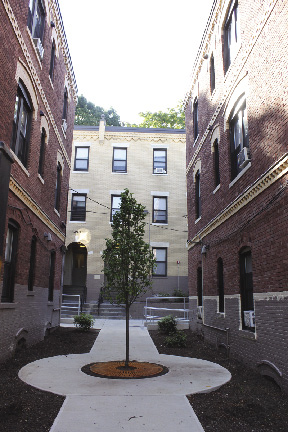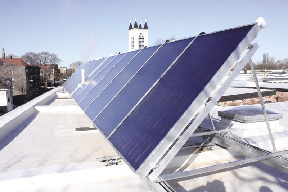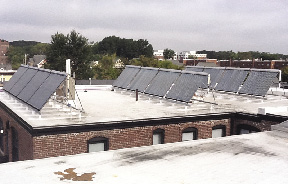"We're already starting to see the payoff", said Noah Maslan, director of real estate at Urban Edge, a community development corporation (CDC) based in the Roxbury section of Boston. He was talking about the green renovation of the agency's Jamaica Plain (JP) Apartments, which was completed last December.
JP's 103 rental units are in 11 buildings in Dorchester, Jamaica Plain, and Roxbury. Most are 3- and 4-bedroom apartments, hard to find in the Boston market. All are Section 8-subsidized. The buildings are located near transit and bus lines, commercial centers, schools, health clinics, parks, and police and fire stations. "Smart Growth" and "Transit-Oriented Development" apply not only to new construction. Preservation of existing housing can also serve these values.
The property was in disrepair when Urban Edge purchased it from HUD in 1982. The buildings are all three-story brick walk-ups, historically significant, and nearly 100 years old. There had not been a major renovation of JP Apartments in over 30 years.
Renovation Scope
Urban Edge received funding from the US Treasury, the Commonwealth of Massachusetts, the City of Boston and the Federal Home Loan Bank of Boston as well as from Enterprise Green Communities, the Boston Redevelopment Authority, the Home Depot Foundation and the Local Initiatives Support Corp. (LISC). These funds allowed Urban Edge to hire an energy efficiency consultant and implement additional green features in the $10.5 million rehabilitation project.
Energy Savings Plan: An energy utility analysis projected that savings of 24% on gas, 50% on electricity and 28% on water and sewer could be achieved. To achieve these savings, exterior wall insulation, inter-floor insulation, air sealing at the roofs and basements, high-efficiency heating and hot water systems, separate metering, efficient lighting and water-conserving appliances and devices were installed. The Home Depot Foundation and the LEAN Multifamily Program funded and awarded solar/thermal hot water systems for two of the eleven buildings. White roofing was installed on all buildings. Pre- and post-construction blower door tests of the buildings showed average Home Energy Rating System (HERS) improvements of 34%.
Indoor Air Quality: Moisture and mold problems called for gut renovation of the bathrooms, new 2-speed, 24-hour exhaust fans in kitchens and bathrooms, and removal of un-vented washing machines and dryers. Common laundry facilities with Star-rated high efficiency equipment were installed in six buildings. Low/no VOC products were used in all applications. The goal is to significantly improve the indoor air quality for a population with high incidence of asthma.
Code/Building Integrity: Sprinkler system and fire protection system upgrades, separation of storm and sewer lines, and substantial masonry and structural work brought the buildings up to code.
Green Standards: In January 2012, the project received certification under the Enterprise Green Communities criteria, exceeding the minimum certification level by 24 points. Urban Edge also implemented its own Green Housing at Urban Edge (Green HUE) standards, which take a whole building systems approach to design. The project's high efficiency building envelopes, lighting and flooring, Energy Star appliances, non-toxic materials high in recycled content, construction recycling (85%), and renewable energy demonstrated that green buildings can be affordable and cover minor incremental costs.
Resident Participation
Residents were actively involved throughout the life of the project. A resident survey determined the issues that residents wanted to be addressed by the renovation. Residents volunteered to be building captains. Staff met with the building captains on a regular basis to provide design and construction updates and to receive feedback from the residents. Building captains briefed residents and distributed information. Workshops examined the benefits and uses of the new heating systems and exhaust fans and introduced green cleaning methods. Green Posters, which highlight ways of saving energy, were installed in the tenants' units and in the laundry rooms.
"It was great to work on this project with Urban Edge who like Vertec is committed to bettering our communities using Innovative Green Construction Standards," said William Faradie, III, LEED AP, senior project manager for the project construction manager Vertec Corp.
Mike Hogan of Paradigm Partners said, "The solar hot water system, often referred to as solar thermal, installed at Urban Edge's 337 Harvard St. building in Jamaica Plain is a successful example of a program aimed at introducing emerging clean technologies into the market successfully. Solar thermal systems lag behind their solar PV (electricity) counterparts in both market application and contractor experience. Ironically, Solar thermal systems capture sun's energy more efficiently than PV does.
"In efforts to increase the market size to capture commercial properties like 337, Paradigm Ptrs. was contracted to provide project management services for the entire program, which included 18 other projects similar to 337. In efforts to drive value and create market consistency, Paradigm's trademarked project management process yielded value engineered designs, reduced installed unit costs, increased bid consistency, kept schedule, and minimized change orders. We've found addressing these five areas are the key to successful commercialization of any new clean technology, regardless if it is a component of the system or a complete system. Addressing these areas drives profitability through the entire supply chain and ensures the deployment was a good experience for the project funder (either public or private) and the building owner.
"We're very fortunate to be in a place like Massachusetts, where the creativity of the population produces incredible clean technology and building owners and funders seek to realize the financial benefits of integrating these technologies into their buildings." said Hogan.









